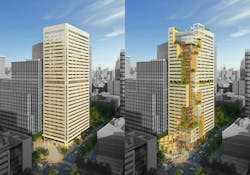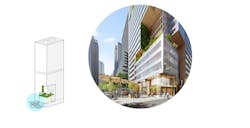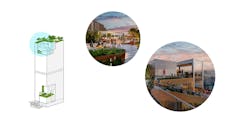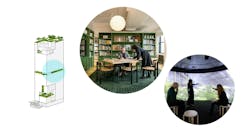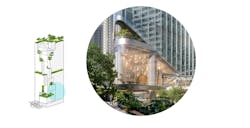4 ways to transform old buildings into modern assets
Cities have doubled in size globally in the last 20 years, yet two-thirds of the commercial building inventory in the U.S. was built before the start of the 21st century. These projects—and even some of their newer counterparts—are aging quickly. As vacancies rise while property values decline, an opportunity presents itself. According to research by real estate services firm JLL, renewing an existing building can increase its market rate by 120%.
With land values continuing to appreciate and structural costs for new construction around 25% to 30% of an overall project, refreshing an existing building provides an immediate yet lower cost entry into the market.
To chart the way forward and draw tenants back, we partnered with JLL to create four cost-effective, scalable design solutions—the “Midlife Metamorphosis”:
- Hit the Streets: Reinvigorate the ground floor.
- Raise the Roof: Reimagine the rooftop as a dynamic hub.
- Cut the Cubicles: Reprogram office floors.
- Modernize the Machine: Upgrade aging building systems.
Better, Faster, Cheaper: Key Benefits of the Midlife Metamorphosis
There are numerous advantages to repurposing an aging high-rise. These include:
- Enhanced speed to market: Typically two years to complete, depending on phase, versus five years
- Decreased cost to build: The ability to target small or medium-sized design interventions versus a new building
- Increased market rate leases: The renewed building could offer equal (if not better) leases than a new tower
- Municipal incentives: In the U.S., many cities offer tax credits and early permitting for building renewals
1. Hit the Streets
Aging towers often feature hemmed-in entrances and closed-off plazas, creating isolated or daylight-starved spaces. To create a more porous, inviting experience that drives neighborhood engagement, building repositionings can target the ground plane, entryway, and lobby zones first.
Design strategies that convert the ground plane into a welcoming “living room” invite the community in with diverse wellness-focused features, activities, and uses. They can also address changing work and lifestyle preferences that seek genuine, authentic connections, and experiences. Serviced and programmed zones can become social magnets with better-than-home conveniences, such as pop-up shops, child care, and volunteer opportunities.
In addition, comfy outdoor furniture and tables, space for a beloved retail anchor (like a neighborhood bookstore coffee shop that hosts evening events), and a lobby that extends outward with larger windows or glass doors can offer engaging experiences for tenants, visitors, and residents. Programmed areas keep these “first impression” spaces active and alive.
2. Raise the Roof
In cities, rooftops offer prime real estate, with sweeping views of the skyline, access to the outdoors, and additional square footage. They also provide unique spaces to build business-to-business synergy, develop partnerships, and spark innovation. Yet many older buildings haven’t optimized these key spaces.
Renewals can transform these unused (or under-used) areas into community-minded hubs to draw tenants in. They can host new and experimental experiences: a destination for nightlight, educational talks, and music events. Design features such as giant steps for seating create a small amphitheater-space for performances and presentations.
Carving out or adding a glass-enclosed area with couches and movable partitions creates a venue space that can convert between more intimate gatherings to larger functions, or even be leased to a local retailer or host rotating pop-up shops.
3. Cut the Cubicles
The office of the future is about building interpersonal connections through friendships and camaraderie. To attract tenants back, new programs for underutilized office floors can provide dynamic and enticing places that are unlike traditional workplaces. As hybrid work becomes the norm, the typical office as we know it is evolving, making way for more creative setups, from innovative atelier and maker spaces to different uses—such as apartments or residences or even dry lab spaces.
These workplaces can also support alternative income opportunities through shared amenities for all tenants and the community, promoting continuous learning and networking.
Renewals offer opportunities to start small by redesigning one workspace, an office floor or multiple levels, serving as a test lab to refine and iterate the design. Office spaces could become workspaces for fashion designers, filmmakers, or even robotics research and development.
Design transformations that open several floors into double or triple-height spaces can create more light-filled, collaborative work environments or serve as lofted living areas. The mechanical floors of the building could become a green mezzanine, a shared central space with restorative plants, outdoor terraces and lounge-like furniture. Simple moves to bring in new lighting fixtures, custom built-in seating and tables, indoor planters, and environmental graphics can also rethink how tenants use the space.
4. Modernize the Machine
In addition to reimagining key spaces to host new experiences, repositioning an older high-rise provides opportunities to replace aging building systems. New solutions can speak to more discerning generations that seek authentic commitments to environmental health and recovery.
By prioritizing the health of people and planet, updating the “nuts and bolts” of the building creates infrastructure that is healthier, more sustainable and seismically sound. These can include elements such as operable windows, expanded tree canopies and building materials that reduce carbon.
Furthermore, some cities require these updates—with many other urban centers soon to follow suit—to meet current building codes and structural standards. Seismic upgrades extend the lifespan of a building and can enhance marketability ahead of any code-enforced mandates.
MEP updates can also make buildings healthier, through more energy-efficient heating and cooling systems, while freeing up valuable real estate for other uses. Paired with exterior updates, such as operable windows and solar panels, these structural upgrades can improve a building’s overall performance.
From engaging entry experiences that activate downtowns to dynamic rooftops that create compelling brand experiences, phased commercial building renewals anticipate the shifting needs of communities, businesses, and individuals. These smaller scale, timed interventions offer a future proofed strategy that can evolve and adapt over time as preferences change. By providing coordinated opportunities to incrementally invest toward more connective spaces, commercial repositionings power innovative experiences for tenants, visitors, and the community at large.
